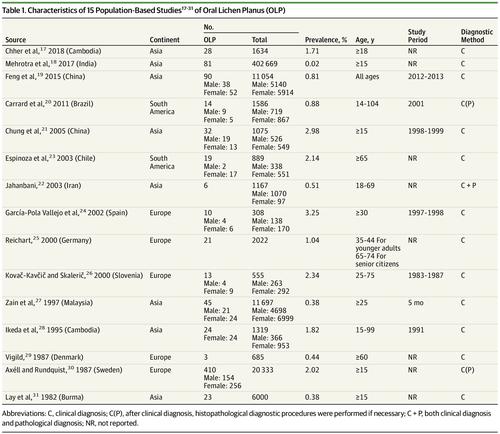当前位置:
X-MOL 学术
›
JAMA Dermatol.
›
论文详情
Our official English website, www.x-mol.net, welcomes your
feedback! (Note: you will need to create a separate account there.)
Global Prevalence and Incidence Estimates of Oral Lichen Planus: A Systematic Review and Meta-analysis.
JAMA Dermatology ( IF 11.5 ) Pub Date : 2020-01-02 , DOI: 10.1001/jamadermatol.2019.3797 Changchang Li 1 , Xiaoqiong Tang 2 , Xiaoyan Zheng 3 , Shuqi Ge 3 , Hao Wen 3 , Xiaoqiong Lin 1 , Zhiwei Chen 1 , Liming Lu 3
JAMA Dermatology ( IF 11.5 ) Pub Date : 2020-01-02 , DOI: 10.1001/jamadermatol.2019.3797 Changchang Li 1 , Xiaoqiong Tang 2 , Xiaoyan Zheng 3 , Shuqi Ge 3 , Hao Wen 3 , Xiaoqiong Lin 1 , Zhiwei Chen 1 , Liming Lu 3
Affiliation

|
Importance
Integrated information on the global prevalence and incidence of oral lichen planus (OLP) is lacking.
Objective
To examine the global prevalence and incidence of OLP in a systematic review and meta-analysis.
Data Sources
A systematic review of population-based studies and clinic-based studies reporting the prevalence and incidence of OLP was performed using 3 electronic medical databases (Cochrane Database of Systematic Reviews, Embase, and MEDLINE) from their inception to March 2019. The search terms included "(lichen planus or LP) and (prevalence or incidence or epidemiology)." No language restriction was applied.
Study Selection
Observational descriptive studies investigating the prevalence and incidence of OLP were included.
Data Extraction and Synthesis
Data were extracted by continent, sex, and other characteristics. The risk of bias was assessed by the Joanna Briggs Institute Critical Appraisal Instrument for Studies Reporting Prevalence Data using random-effects models to synthesize available evidence.
Main Outcomes and Measures
The primary outcome was the prevalence (with 95% CIs) of OLP among the overall population and among subgroups. Between-study heterogeneity was assessed using the I2 statistic.
Results
Among 46 studies, the overall pooled estimated prevalence of OLP was 0.89% (95% CI, 0.38%-2.05%) among the general population (n = 462 993) and 0.98% (95% CI, 0.67%-1.43%) among clinical patients (n = 191 963). Among the 15 population-based studies, the prevalence of OLP was 0.57% (95% CI, 0.15%-2.18%) in Asia, 1.68% (95% CI, 1.09%-2.58%) in Europe, and 1.39% (95% CI, 0.58%-3.28%) in South America. Among the 31 clinic-based studies, the prevalence was 1.43% (95% CI, 1.12%-1.83%) in Africa, 0.87% (95% CI, 0.61%-1.25%) in Asia, 1.03% (95% CI, 0.51%-2.09%) in Europe, 0.11% (95% CI, 0.07%-0.16%) in North America, and 3.18% (95% CI, 0.97%-9.95%) in South America. The pooled prevalence of OLP by sex was 1.55% (95% CI, 0.83%-2.89%) for women and 1.11% (95% CI, 0.57%-2.14%) for men in the population-based studies and 1.69% (95% CI, 1.05%-2.70%) for women and 1.09% (95% CI, 0.67%-1.77%) for men in the clinic-based studies. In 5 clinic-based studies providing the age distribution of patients with OLP, the prevalence by age was 0.62% (95% CI, 0.33%-1.13%) among patients younger than 40 years and 1.90% (95% CI, 1.16%-3.10%) among patients 40 years and older.
Conclusions and Relevance
This study identified the global prevalence and incidence of OLP in terms of its spatial, temporal, and population distribution. The overall estimated pooled prevalence of OLP was 0.89% among the general population and 0.98% among clinical patients. A higher prevalence of OLP was found in non-Asian countries, among women, and among people 40 years and older. The findings should be considered with caution because of the high heterogeneity of the included studies.
中文翻译:

口腔扁平苔藓的全球患病率和发病率估算:系统评价和荟萃分析。
重要性缺乏有关全球口腔扁平苔藓(OLP)患病率和发病率的综合信息。目的通过系统评价和荟萃分析来检查OLP的全球患病率和发生率。数据来源从成立至2019年3月,使用3个电子医学数据库(系统评价,Embase和MEDLINE的Cochrane数据库)对基于人群的研究和基于临床的研究报告了OLP的发生率和发生率进行了系统的综述。术语包括“(扁平苔藓或LP)和(患病率,发病率或流行病学”)。没有语言限制。研究选择包括观察性描述性研究,旨在调查OLP的发生率和发生率。数据提取和综合数据是按洲,性别和其他特征提取的。乔安娜·布里格斯研究所的研究报告评估流行性数据的关键评估工具使用随机效应模型综合了可用的证据,对偏倚的风险进行了评估。主要结果和措施主要结果是总人口中和亚组中OLP的患病率(CI值为95%)。使用I2统计量评估研究之间的异质性。结果在46项研究中,总人群(n = 462993)中OLP的总体合并估计患病率为0.89%(95%CI,0.38%-2.05%)和0.98%(95%CI,0.67%-1.43%)在临床患者中(n = 191963)。在15项基于人群的研究中,亚洲的OLP患病率为0.57%(95%CI,0.15%-2.18%),欧洲为1.68%(95%CI,1.09%-2.58%),以及1.39%(95) %CI,0.58%-3.28%)。在31项基于临床的研究中,非洲的患病率为1.43%(95%CI,1.12%-1.83%),亚洲为0.87%(95%CI,0.61%-1.25%),欧洲为1.03%(95%CI,0.51%-2.09%) ,在北美为0.11%(95%CI,0.07%-0.16%),在南美为3.18%(95%CI,0.97%-9.95%)。在基于人群的研究中,女性的OLP合并患病率为1.55%(95%CI,0.83%-2.89%),男性为1.11%(95%CI,0.57%-2.14%),为1.69%(95)在基于临床的研究中,女性的CI为1.05%-2.70%,男性为1.09%(95%CI为0.67%-1.77%)。在5个提供OLP患者年龄分布的临床研究中,年龄在40岁以下患者中的患病率为0.62%(95%CI,0.33%-1.13%)和1.90%(95%CI,1.16%- 40岁以上的患者中占3.10%)。结论和相关性这项研究从OLP的时空,空间,和人口分布。总体估计的OLP合并患病率在普通人群中为0.89%,在临床患者中为0.98%。在非亚洲国家,妇女以及40岁及40岁以上的人群中,OLP的患病率较高。由于纳入研究的高度异质性,应谨慎考虑研究结果。
更新日期:2020-02-12
中文翻译:

口腔扁平苔藓的全球患病率和发病率估算:系统评价和荟萃分析。
重要性缺乏有关全球口腔扁平苔藓(OLP)患病率和发病率的综合信息。目的通过系统评价和荟萃分析来检查OLP的全球患病率和发生率。数据来源从成立至2019年3月,使用3个电子医学数据库(系统评价,Embase和MEDLINE的Cochrane数据库)对基于人群的研究和基于临床的研究报告了OLP的发生率和发生率进行了系统的综述。术语包括“(扁平苔藓或LP)和(患病率,发病率或流行病学”)。没有语言限制。研究选择包括观察性描述性研究,旨在调查OLP的发生率和发生率。数据提取和综合数据是按洲,性别和其他特征提取的。乔安娜·布里格斯研究所的研究报告评估流行性数据的关键评估工具使用随机效应模型综合了可用的证据,对偏倚的风险进行了评估。主要结果和措施主要结果是总人口中和亚组中OLP的患病率(CI值为95%)。使用I2统计量评估研究之间的异质性。结果在46项研究中,总人群(n = 462993)中OLP的总体合并估计患病率为0.89%(95%CI,0.38%-2.05%)和0.98%(95%CI,0.67%-1.43%)在临床患者中(n = 191963)。在15项基于人群的研究中,亚洲的OLP患病率为0.57%(95%CI,0.15%-2.18%),欧洲为1.68%(95%CI,1.09%-2.58%),以及1.39%(95) %CI,0.58%-3.28%)。在31项基于临床的研究中,非洲的患病率为1.43%(95%CI,1.12%-1.83%),亚洲为0.87%(95%CI,0.61%-1.25%),欧洲为1.03%(95%CI,0.51%-2.09%) ,在北美为0.11%(95%CI,0.07%-0.16%),在南美为3.18%(95%CI,0.97%-9.95%)。在基于人群的研究中,女性的OLP合并患病率为1.55%(95%CI,0.83%-2.89%),男性为1.11%(95%CI,0.57%-2.14%),为1.69%(95)在基于临床的研究中,女性的CI为1.05%-2.70%,男性为1.09%(95%CI为0.67%-1.77%)。在5个提供OLP患者年龄分布的临床研究中,年龄在40岁以下患者中的患病率为0.62%(95%CI,0.33%-1.13%)和1.90%(95%CI,1.16%- 40岁以上的患者中占3.10%)。结论和相关性这项研究从OLP的时空,空间,和人口分布。总体估计的OLP合并患病率在普通人群中为0.89%,在临床患者中为0.98%。在非亚洲国家,妇女以及40岁及40岁以上的人群中,OLP的患病率较高。由于纳入研究的高度异质性,应谨慎考虑研究结果。











































 京公网安备 11010802027423号
京公网安备 11010802027423号